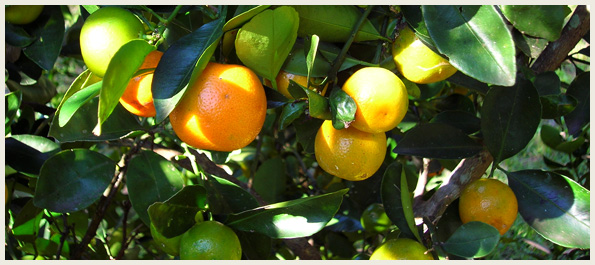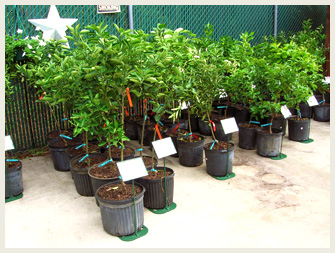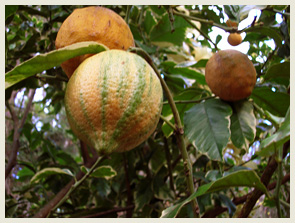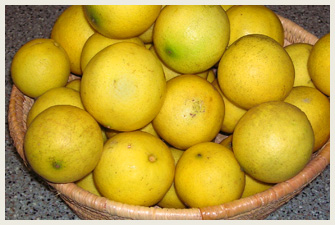Growing Your Own Citrus
Summer's zest, indoors in winter.
By Lynette L. Walther
 Calamondin fruits are small and a brilliant orange. The sour citrus can be used to make a tasty marmalade.
Calamondin fruits are small and a brilliant orange. The sour citrus can be used to make a tasty marmalade.
Growing your own citrus indoors is easy if you are willing to pamper the plants a bit.
Photo: Lynette L. WaltherImagine bright green leaves, sprightly little blossoms that look like a multitude of stars, a scent that perfumes the air, and colorful fruit ripening on the branch. Now, imagine all this in your home in the depths of winter. It’s not a dream, it’s what you get when you grow citrus in a pot, which is actually easier than you might suspect.
All you need is a large a sunny window, and a suitable citrus variety.
 Choices, choices…A full-service nursery will have a variety
Choices, choices…A full-service nursery will have a variety
of potted citrus from which to choose. Or try mail order firms.
Photo: Lynette L. WaltherGrowing citrus in a pot is nothing new. In the sixteenth century it was all the rage in Europe where huge “orangeries” were created with elaborate conservatories that had sprinkler systems and steam heat. You don’t need a big greenhouse, but you’ll need to supply a bit of pampering to successfully grow citrus indoors. However, there are few indoor plants that can give such pleasure.
Here are the ground rules:
• Select one of the new dwarf citrus varieties, or (better yet) opt for one of the small-fruited varieties such as calamondin, kumquat, or lemon. The latter can be kept trimmed short and all will stay in proportion to their fruits. All citrus must be protected from sub-freezing temperatures or prolonged freezing, although many citrus varieties can withstand near-freezing temperatures for short periods of time. Kumquats and Satsumas are among the most cold-hardy. Meyer lemons are seedless, with pale green flesh and no seeds. Key limes produce nice, small fruits with few seeds. The Kaffir lime has aromatic leaves that can be used in cooking, and produces a bumpy-skinned fruit that is also edible.
 The striped fruit of a variegated lemon is red to pink inside,
The striped fruit of a variegated lemon is red to pink inside,
and the leaves are a pleasing silvery green splashed with cream.
This colorful fruit is just one example of the variety
of citrus trees one can grow in a pot.
Photo: Lynette L. Walther• Remember that all citrus will bloom (usually sometime around Valentine’s Day), since it needs pollination in order to produce fruit. Even without fruit, citrus blossoms themselves are heavenly. Limes and lemons often bloom multiple times from spring through the summer. Because it is more likely that these varieties will be pollinated during summer months when the trees are outdoors, both are good choices for indoor growers who want to increase chances of growing fruit. I especially like my variegated lemon with its red-pink fruits and silvery-green leaves that are splashed with cream.
• Plant your tree in a large container, preferably one on casters. That will make it easier to move the plant outdoors when the weather warms up and the danger of freezing has passed. Ceramic containers or the newer lightweight synthetics are good choices, as is a wooden planter, provided it can hold water and offer good drainage as well.
• A good quality potting mix should be used, and expect to water the little tree as needed. Avoid keeping the soil soggy, however. Citrus does not tolerate “wet feet.” The average tree will require about a half gallon of water each week, or enough to keep soil from drying out completely. While the tree is growing (during warmer months), add nutrients regularly. Withhold fertilizers during dormancy.
• Plant your tree at the same level at which it was planted in the container it came in, even if it appears some of the roots are growing along the surface. Individual seeds of most citrus fruits can also be planted for “free” trees. However these seeds will take many years to mature into fruiting trees. Most citrus plants you can purchase have been grafted onto a hardy rootstock.
 Imagine a basket brimming with tangy Key limes.
Imagine a basket brimming with tangy Key limes.
Photo: Lynette L. Walther• During the winter, provide as much sun as possible for the tree, via a sunny window or bright area beneath a skylight. Or use a full-spectrum light source from morning to evening. Once temperatures warm up, move the tree outdoors into full sun, gradually acclimating it to the bright light. Likewise gradually reduce exposure to the sun as you prepare it for its return indoors for the winter.
• Expect some leaf drop once the tree is moved back indoors, due to the inevitable decrease in humidity. As a rule citrus trees do not experience a general loss of leaves unless they are critically ill. Provide as much humidity to your tree as possible while it is indoors. Mist the leaves periodically, use a humidifier, and keep it away from heater vents.
• Not many insects are interested in the pungent leaves of citrus, but mealy bugs and scale can be a problem in dry environments. An organic insecticidal soap or Neem oil can be used if either are found.
• Prune the tree to keep it in shape and to increase branches. Pruning can be done beginning in April and should be discontinued after September. Repot the tree as needed.
Check local nurseries for suitable citrus varieties. Mail order sources include Logee’s Growers, 888-330-8038 or at: www.logees.com and Four Winds True Dwarf Citrus Growers, www.fourwindsgrowers.com.

 Calamondin fruits are small and a brilliant orange. The sour citrus can be used to make a tasty marmalade.
Calamondin fruits are small and a brilliant orange. The sour citrus can be used to make a tasty marmalade. Growing your own citrus indoors is easy if you are willing to pamper the plants a bit.
Photo: Lynette L. Walther
 Choices, choices…A full-service nursery will have a variety
Choices, choices…A full-service nursery will have a varietyof potted citrus from which to choose. Or try mail order firms.
Photo: Lynette L. Walther
 The striped fruit of a variegated lemon is red to pink inside,
The striped fruit of a variegated lemon is red to pink inside, and the leaves are a pleasing silvery green splashed with cream.
This colorful fruit is just one example of the variety
of citrus trees one can grow in a pot.
Photo: Lynette L. Walther
 Imagine a basket brimming with tangy Key limes.
Imagine a basket brimming with tangy Key limes. Photo: Lynette L. Walther

Contributing Garden Editor Lynette L. Walther is the recipient of the National Garden Bureau’s Exemplary Journalism Award and the IABC Silver Quill Award of Excellence. She is a member of the Garden Writers Association. She gardens in Camden.
Related Articles
Share this article:
2023 Maine Boat & Home Show

Join Us for the Maine Boat & Home Show!
Art, Artisans, Food, Fun & Boats, Boats, Boats
August 11 - 13, 2023 | On the waterfront, Rockland, Maine
Click here to pre-order your tickets.
Show is produced by Maine Boats, Homes & Harbors magazine.















